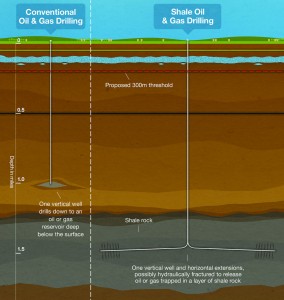According to one theory, the temple of the Oracle of Delphi, an ancient Greek priestess, was located above an ancient natural gas spring. Geochemical analyses suggest that the Oracle would inhale natural gas and enter a trance-like state as she delivered her prophecies.
Modern uses of natural gas have progressed significantly since the days of the ancient Greeks. Today, natural gas is second only to coal with regards to energy production in the United States. Advances in two key technologies—directional drilling and hydraulic fracturing—have driven the growth of the natural gas industry in recent years. Directional drilling involves digging non-vertical or even curved wells to access obstructed deposits, while hydraulic fracturing, commonly known as fracking, drives high-pressure fluids through these wells to fracture the surrounding rock.
Over the last decade, new applications of these methods have led to a substantial rise in the domestic production of natural gas: from effectively nothing in 2000 to over 10 billion cubic feet per day in 2010. Production is projected to quadruple by 2040. This unchecked growth has been met with increasing concerns over associated environmental and human health risks.
In a January 2016 paper, a research team led by Yale School of Public Health professor Nicole Deziel investigated over 1,000 chemicals associated with hydraulic fracturing. Although they found little to no toxicity information for nearly three-quarters of the evaluated substances, the team discovered that many were linked with adverse reproductive and developmental effects.
In hydraulic fracturing, millions of gallons of fracturing fluids—a mixture of water, chemicals, and sand—are injected into deep underground wells at high pressures, producing fractures in the nearby rock that release natural gas. The injected fluids, along with a potentially harmful mixture of displaced, naturally occurring chemicals, gradually return to the surface as wastewater. Though the wastewater is carefully collected for disposal, surface water and groundwater contamination from equipment failure or underground seepage remains possible.
Furthermore, despite the procedural safeguards against contamination, official regulation at the federal level is surprisingly low. Under the Energy Policy Act of 2005, hydraulic fracturing chemicals were largely exempt from complying with the Safe Drinking Water Act’s Underground Injection Control Program, which establishes requirements to ensure the integrity of underground drinking water sources.
With limited federal oversight, a combination of environmental and health concerns has led to the emergence of a vigorous anti-fracking movement. Still, proponents of unconventional natural gas argue that it is an inexpensive alternative to other fuels such as coal and oil, which are linked to higher levels of air pollution.
Attempting to address the debate over fracking, Yale researchers systematically checked 1,021 chemicals—including heavy metals, organic solvents, and naturally-occurring radioactive materials—against an online database maintained by the Reproductive Toxicology Center. Of the 240 chemicals that possessed sufficient toxicity information, 157 were identified as possible reproductive or developmental toxins.
Their analysis is a crucial first step toward understanding the impact of hydraulic fracturing on public health, particularly within communities situated near fracking sites. In the last year, over 8.6 million people in the US used a drinking water source located within one mile of a hydraulic fracturing site.
As part of their findings, researchers also recommended 67 chemicals as the focus of future health studies on hydraulic fracturing. Because these prioritized substances have either current or forthcoming quantitative standards, they represent the most sensible starting point for future human exposure assessments. “This was a systematic evaluation to prioritize these chemicals and get a better handle on their potential health effects,” Deziel said.
By narrowing down the extensive list of chemicals to a few of particular interest, the research has also laid the groundwork for more focused and effective environmental testing. “We’re planning on collecting water samples to evaluate whether proximity to hydraulic fracturing activities is associated with elevated levels of potential contaminants,” said Elise Elliott, a fourth year graduate student who was the study’s lead author.

Although preliminary water and environmental contamination studies are already in progress, crucial health-related information about a majority of the chemicals found in fracking fluids and wastewater is missing. “This reflects a broader issue in environmental health where we have a very poor understanding of the toxicity of many consumer products that we use,” Deziel said.

